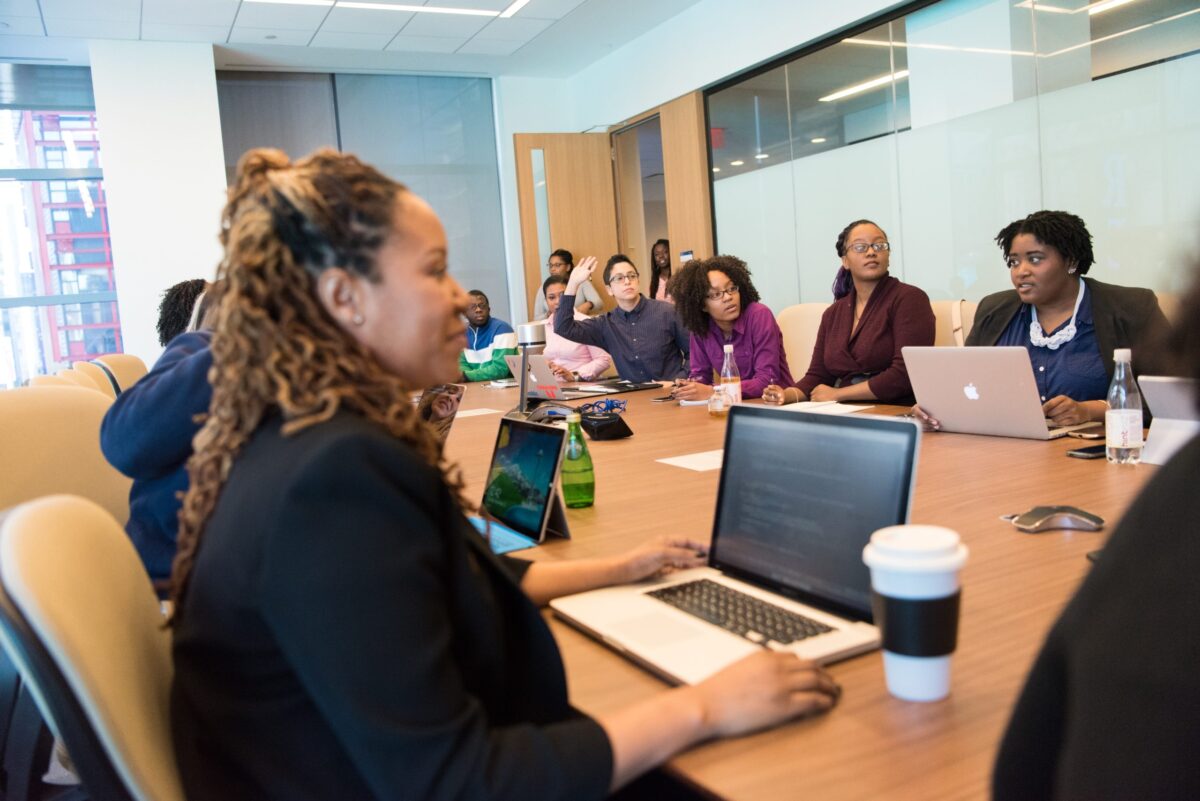
You’ve just been attacked verbally by a super-irate member of your meeting. Your heart is pounding. Your eyes are wide. The rest of the group is focused on you for help. What the heck?! Who signed me up for this???!!!!
Here’s one technique to feel more centered and apart from your own emotional reactions when aggression is expressed. Experience yourself observing while simultaneously leading. You can take an emotional step back from involvement in the group by imagining that you’re watching a movie; the story is unfolding before your eyes and you can watch and think about the characters, the plot and the implications from a slightly removed vantage point. We thereby spare ourselves the stress and high emotions that can distort perceptions of the findings as well as jeopardize our ability to lead.
By the way, in marketing research focus groups, this is excellent advice for the observers in the backroom. As we’ve all experienced, it’s often difficult for clients to hear negative and emotionally charged feedback about their brain children. And, who could blame them? Their jobs are on the line. Their self-esteem about their own creative process which brought the test ideas into being are being challenged and shot down in a moment, while they may have spent months or even years coming to the point where they are brave enough to expose them to their audiences. It’s natural that clients are likely to take any attacks on their products and advertising personally making it difficult to listen with an open mind.
It is therefore a wise idea for clients to have the safety of the movie metaphor. And it works well with the focus group set up. Watching the “movie” through the glass is a logical extension of the physical environment. The window is like a large screen. The seats are lined up in tiers. It’s dark like a movie theatre. Many facilities even serve popcorn to encourage the sense of more passive viewing and listening.
However, it’s a totally different situation in the front room as the leader. The facilitator might pretend that she/he is the focusing lens of the camera, but… the problem occurs when the monster in the movie slowly turns its head, catches the camera’s eye and focuses his fury right into the audience’s face. We all know how frightening that is when that character seems to come off the big screen and become aware of you as viewer. Our safe seat in the auditorium is now confronted by the scary beast. An icy chill streaks up our spine. Our hearts begin to race. Our eyes widen. Some will utter a frightened, HUH!! If the change
in the monster’s demeanor and attention comes out of the blue, the intensity of our reactions is greater.
Imagine how much worse that is when an angry group member captures the moderator’s eye and blasts him/her with a tirade of emotion intended for God knows what, his boss, his father/mother, or anyone else who has made them angry. While we can sit safely in the movie theatre just having our momentary feeling of fright, in the leader’s seat we must have strategies in place for dealing with these people.
Art Shulman, a friend of mine who has attended our training and learned about our Snow White Theory for dealing with the various types of characters in the group, wrote a comic tongue-in-cheek account of his version of The Hulk appearing in one of his sessions.
Here’s a synopsis and a small excerpt. Thank you Art!:
Apparently, an already transformed, surly, Hulk-like look-a-like known as “Beast” presented himself in one of Art’s groups (or perhaps hypothetical groups). In the go round he growled and snarled at the group and at Art. Art, silently, but frantically tried to recall all of the interventions he had learned to employ in dealing with difficult people. He jokingly reflects to himself things like:
- Slip him a Mickey?
- Pull out a can of Mace?
- Use the ejector seat?
Then he tells us that he remembered the seating position behavior he learned about for working with difficult respondents. He invites Beast, AKA Grumpy or Hulk who is sitting in the confrontational, counter-leadership position at the end of the table to switch seats with Happy who is sitting in the compliant seat to the leader’s immediate right. He correctly explains that the chair opposite the leader is likely to be taken by a provoking, challenging character. One way to change behavior is to literally change the person’s seat.
In Art’s Group Thriller, he has this Grumpy Beast switch his seat with Happy, the character most likely to support the leader. Then Art announced to the group that the topic of the session was Christmas stockings, where upon our Grumpy Hulk uttered a thunderous rumbling sound like that of a volcano about to erupt, turned to him and the people in the backroom, and in growing ferocity picked up a chair and flung it at the mirror.
Once our imaginary respondent, Beast, released the pent up frustration that had been growing to a breaking point, he was able to express the softer feelings and reasons why.
In Art’s words:
“Then, as we all looked on, Beast sat back down and became tearful,. .’Every December I apply for jobs as Santa Claus. But I’m always rejected once they find out I’m a professional wrestler’
For the rest of the session he was a pussycat, making all sorts of useful suggestions to increase sales of my client’s product”
* * *
With just a little luck, nothing this extreme will ever happen to you when you’re leading a group or meeting. Yet there is that nagging old Murphy reminding us that anything can and will. The sheer knowledge of this possibility, no matter how rare, keeps us needing to have an approach to handle the most difficult respondents even though most groups are comprised of amiable, cooperative people.
An important intervention for your consideration:
I would like to suggest a little tactic to have in your back pocket that you can rely on if Murphy and The Hulk show up in your meeting and scare you with a roar and the mighty muscle that looks like he can back it up. It is a very simple technique that diffuses the raw emotion of this grumpy person. And remember, all of us have the capacity for being quite grumpy at times, when provoked.
The unexpected outburst starts. Allow the participant to vent and finish his/her little tirade. You will be feeling the attack and so will the rest of the group. If you are like most people when confronted with such a strong assault your heart is racing and you probably feel a little frightened yourself not unlike the shock I felt when the computer came crashing down on my head out of seemingly nowhere.
Remind yourself to take a breath. It will be over soon.
You can give yourself time to think and recover from your pounding heart and dazed feeling AND at the same time, help this angry person calm down by saying: “I am sorry could you repeat that…I want to be sure I really understood what you said.”
While it may sound counter intuitive to invite this furious fomentation to be unleashed yet again, it actually has the reverse effect. It is at once both an extraordinarily simple AND extraordinarily powerful intervention.
Here’s why:
– Asking the person to repeat what was just expressed protects you from attempting to engage in a rational conversation with an irrational person (which is kind of like
trying to get your dog to teach you Calculus … you’ll just irritate him and get him to bark louder).
Our job is to keep the group communication constructive, reasonably logical and goal oriented (despite any needs to recognize emotional motivation.) The overly aggressive attacker is not able to contribute to this in their initial state of anger.
– Second, the meaning and intent of the overly aggressive communication is usually quite clouded by the intensity of his adrenalin. It’s hard to decipher the meaning and
implications out from underneath the intensity of his emotional outburst.
The tone of your voice should communicate genuine interest in hearing the meaning of his/her words. You are asking so that you can help this person better articulate what they are thinking.
Like the Hulk who requires a build up of energy to fuel his fiery temper, the aggressive participant’s raw emotion has been spent. It will take time, energy and a sense of annoyance and irritation to rebuild for there to be another volcanic eruption. When the participant repeats what was originally spat out in a rage, he/she will now express it far more calmly with far less feeling and agitation. This will give you an opportunity to:
* Recuperate, calm down, collect your thoughts and think of your next question
* Invite the group to react to the content of his message rather than the inappropriate emotion.
Then, in order to further help Grumpy respond in a way which will help him be more cooperative, ask “object oriented[4], easy questions with regard to the content. Examples would be:
– When did this happen?
– Where were you?
– How did you get there?
– Who was there?
People calm down when given the opportunity to answer simple factual question which have definite answers, having nothing to do with their opinions. (The reason is, opinions reside INSIDE a person’s head … they are ideas one has to ‘defend’, whereas facts are things that are usually more objectively verifiable, thus carrying less of a need for personal
defense).
In contrast, asking a very upset person “why?” (to which they may or may not know the answer, and which certainly puts them on the spot to defend their position) may create more anxiety and refuel their upset.
You might also, (at some point after the problem person has re-verbalized their aggression and been helped to calm down with these simple factual questions), acknowledge the problem or concern he has, then repeat it to the person to make sure you (and the rest
of the group) understands the issue.
What works about this approach?
You demonstrated that you have respect for her/him [as well as the others in the group] by accepting his reaction and wanting to hear more.
You remained apparently calm and avoided counter attacking and dismissing him. (That’s hard to do when someone is attacking you. During an aggressive confrontation, it’s natural to want to fight fire with fire.)
You indicated interest in finding out what he is really thinking and validated him by letting him know that you believe there is an important message beyond the fireworks.
You treated the issue as important to her/him, even though it might not be so for others, showing your interest in his and everyone’s reactions.
You demonstrated acceptance of his feelings to make it possible for him to talk without having to use intense emotional outbursts to get your attention.
You used the window of calm after the storm to reestablish your leadership in the group and take control
At the same time, you gave the other group members a moment to catch their breath too and calm down from the onslaught so you could all return to the task at hand.
Incidentally, Art was right about seating position. It’s much easier for an angry meeting participant to assert dominance and attempt to steal the floor if they can make eye contact with the leader. Acknowledging via eye contact invites the other to talk and interact. [You know how they
say to avoid eye contact with a crazy looking person when you’re walking the streets of Manhattan.] So either change his seat or change the balance of power by getting up, moving around the room and making it difficult for him/her to look you in the eye until this person has demonstrated that she/he can be cooperative.
When all else fails, from another fairy tale, keep a pitcher of water handy to melt the wicked witch. [Just kidding of course, but it’s only fair to note that Super-Grumpies come in both genders].
And remember, Murphy’s law is very unlikely to come to pass. Most meetings are comprised of people who want to be there and share their ideas rather than hitting you on the head with a heavy metal black box.
Hmmmm. Maybe Dennis the flight attendant was the Incredible Hulk?
Wishing you great meetings!
Want to learn more about leading groups? Contact me http://www.DrSharonLivingsto.com to find out about our upcoming training sessions or email me directly at DrSharonLivingston@gmail.com
[1] Wasn’t sure if he was just annoyed with me for invading his space or if he saw my strange behavior as a function of menopausal madness. If he had only known the secrets for assuaging potentially aggressive reactions, we might have had a pleasant flight..
[2] After sharing my experience with other QRC’s I heard a story that topped this one. A moderator was sitting in First Class. During take off, a bottle of wine flew out of the galley, hit her in the head and knocked her unconscious! We really have a high risk occupation, friends.
[3] Grumpy is an icon for one of the 7 characters that show up in any group. Anyone unfamiliar with my metaphor that respondents in a focus group tend to assume the role of one of the seven dwarves from the classic 1800’s tale can visit http://www.snowwhitetheory.com/ for a description of all the postures people take in a group meeting and suggestions for how to handle them
[4] An object oriented question is just a factual question that has an easily identifiable right answer. An opinion might be judged, making the respondent anxious, but factual queries are experienced as safe.




















